The first Old Firm Derby of the 2023/24 campaign will take place tomorrow, with Rangers playing hosts to Celtic at Ibrox. The stage is set for an enticing encounter for Brendan Rodgers’ first major test since returning to Parkhead back in June, though his second Hoops tenure has been far from smooth sailing thus far.
Rodgers’ side are currently goalless in two games, with Kilmarnock eliminating them from the Scottish League Cup a fortnight ago before they were held to a draw by St. Johnstone at Celtic Park last week.
Still leading the Scottish Premiership, they’ll be keen to put the last couple of weeks behind them and set the tone for the campaign by overcoming Michael Beale’s Gers tomorrow.
Turning our attention to the other half of Glasgow, Rangers come into this game directly off the back of a heavy UEFA Champions League playoff defeat to Eredivisie’s PSV Eindhoven — they were defeated 7-3 over two legs but lost 5-1 in Wednesday’s decisive clash.
Derek McInnes’ Kilmarnock also have a victory over Rangers to their name in 2023/24, after they defeated the Gers 1-0 in their Premiership opener back in early-August. As a result of this, Michael Beale’s side currently trail the Hoops by a point as we approach Sunday’s game.
Neither of the two Glasgow goliaths have been majorly convincing so far this season and Sunday’s game is one that really could end up going either way, with both of these teams displaying some notable weaknesses that the other could target already in the 2023/24 campaign.
We’ll aim to highlight those weaknesses along with both teams’ respective strengths in this tactical piece previewing Sunday’s derby. Our analysis will dive into some aspects of both sides’ strategy and tactics that we predict will end up being crucial in deciding this contest. So, let’s get into the analysis, then!
Rangers’ strengths
We’ll start by focusing on both sides’ respective strengths, beginning with the hosts, Rangers. Beale’s side currently boast the lowest xGA (1.76) in Scotland’s top-flight, while also conceding the joint-lowest (one) in terms of actual goals too.
Indeed, as you might imagine based on this information, Rangers’ defensive setup has been extremely solid thus far in the 2023/24 campaign and stands as one of their major strengths heading into Sunday’s clash.
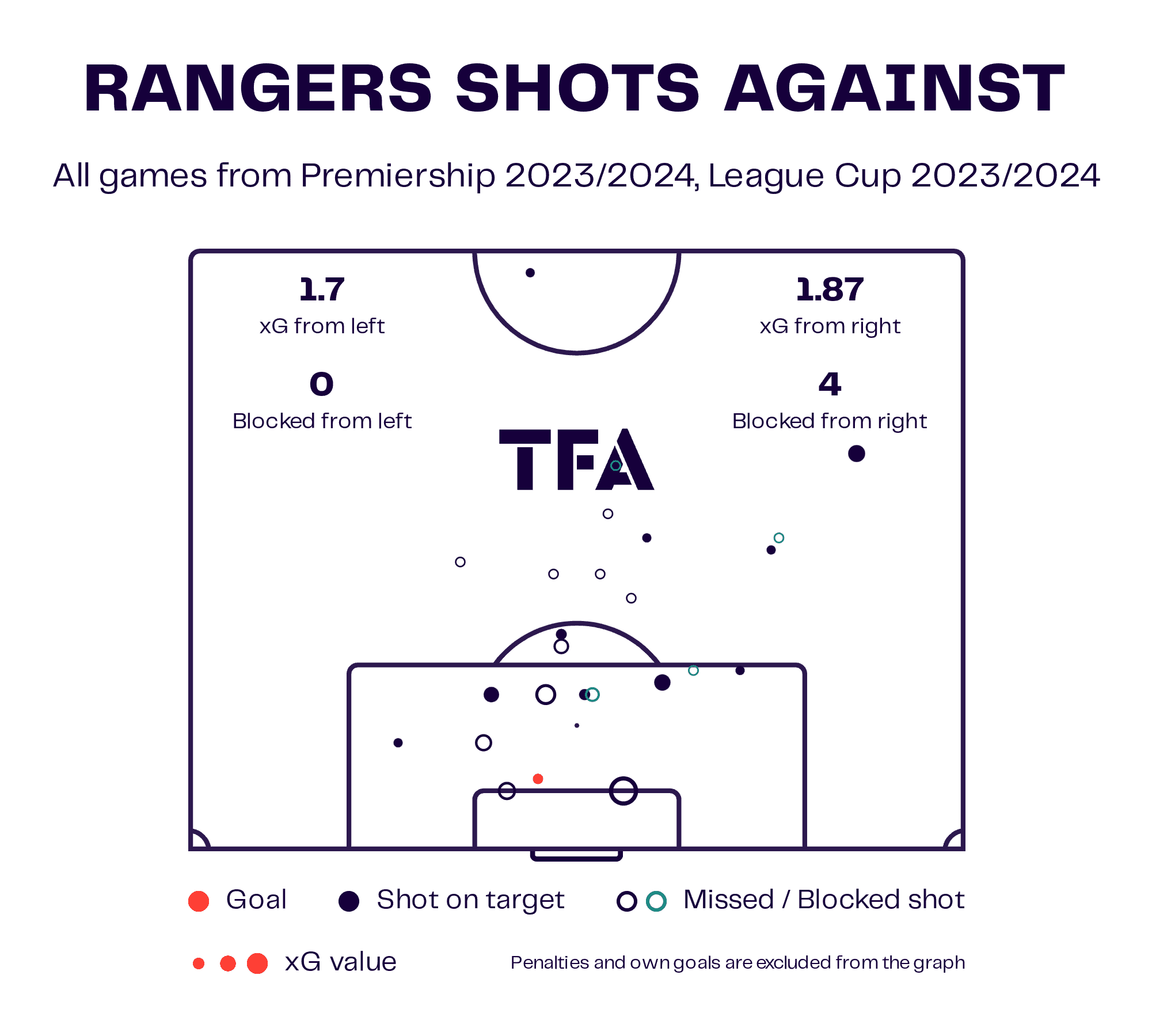
They’ve conceded marginally more xG from the right than the left but both sides are fairly similar in terms of chances conceded — and very low, with very few shots conceded from high-value areas.
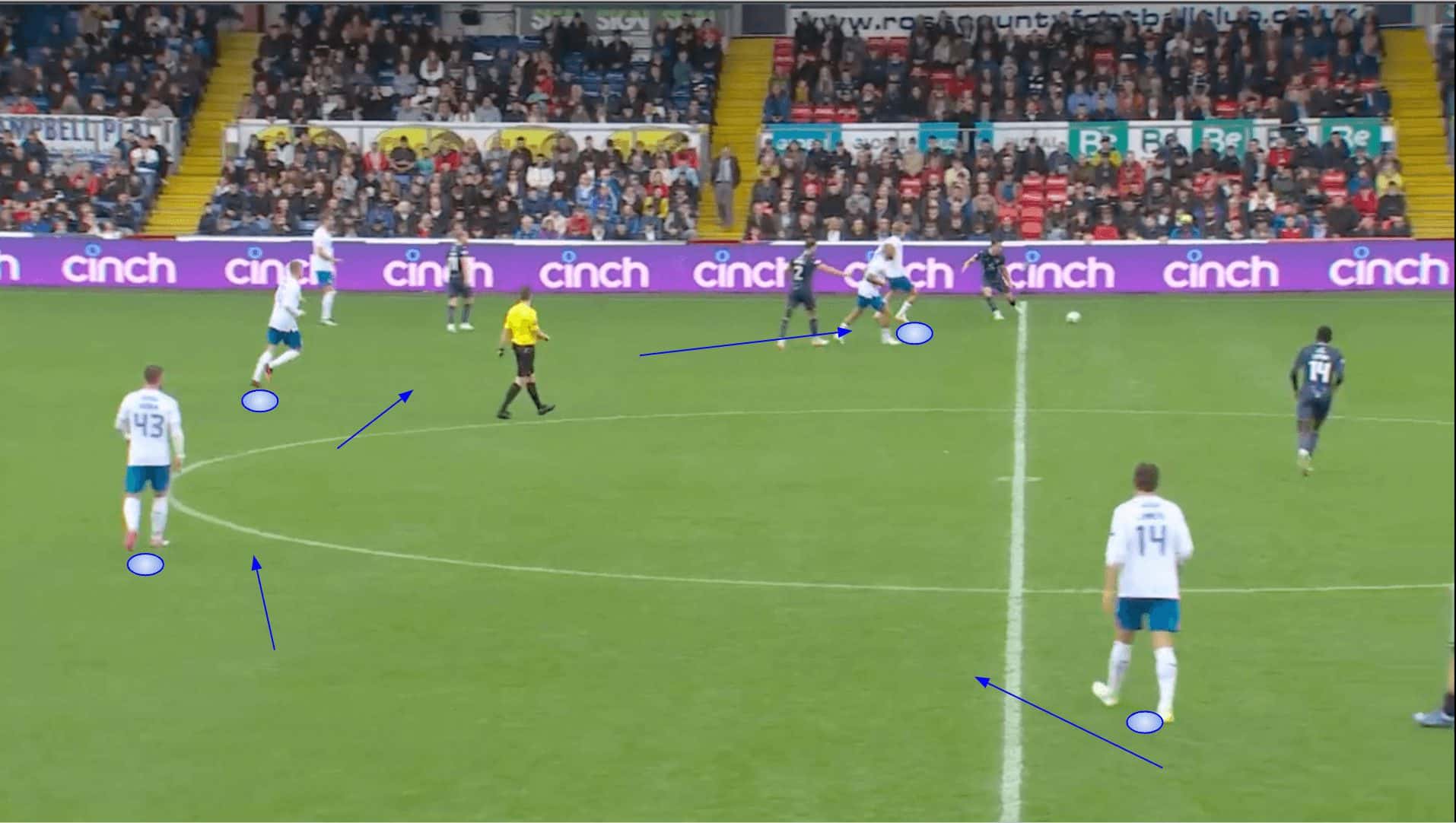
Beale typically sets his side up in a 4-3-3 shape off the ball in domestic competition, though they lined up in more of a 4-4-2 versus PSV and both are viable options worth considering for the derby game.
Rangers like defending in an organised, position-oriented mid-block in which the central midfielders are key to pressing the opposition’s attempted ball progression by denying them clear passing lanes and forcing them back/into awkward areas, as was the case in figure 2 here with left central midfielder Todd Cantwell having committed to the press here.
As Cantwell presses, right-winger Sam Lammers shifts across along with Cantwell’s midfield partners, ensuring he doesn’t allow gaps to open in central midfield as a result of his aggression; this type of organisation and teamwork is typical of Rangers without the ball.
Celtic are probably more aggressive than Rangers without the ball in terms of pressing speed and intensity, which their slightly lower PPDA of 6.04 to Rangers’ 7.37 in the league this term would indicate, but though Rangers generally allow their opponents one extra pass per possession than Celtic, the Gers’ defensive organisation and competence means they’re generally more effective than the Hoops at actually denying the opponent chances.
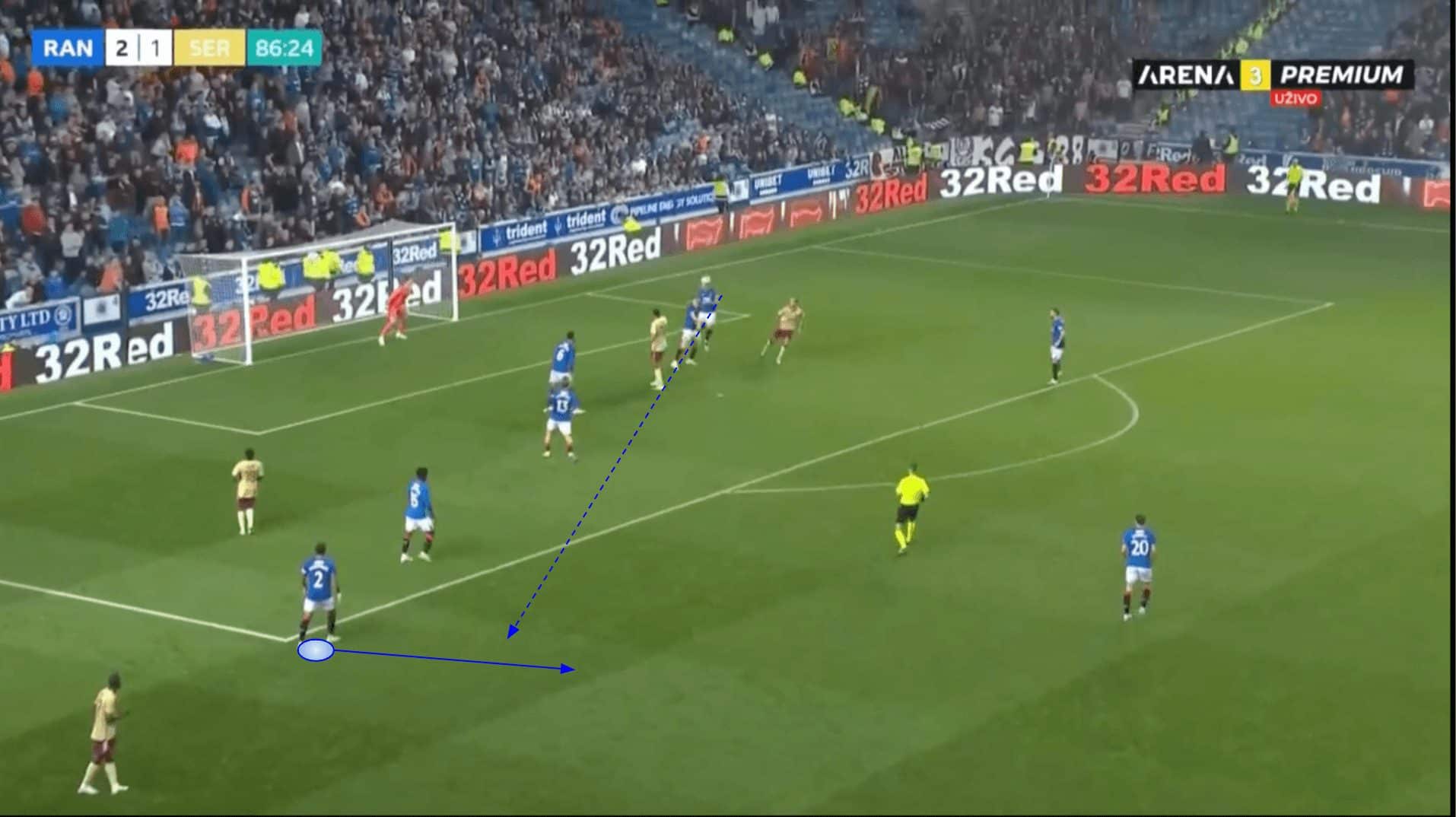
Another area in which Gers excel is their transition to attack. They are lethal on the counter, as these examples from their UEFA Champions League qualification clash with Servette earlier in the summer show.
In figure 3, we see Rangers’ defence dealing with a cross played into the danger zone by their Swiss opponents. The ball is headed away to right-back James Tavernier, who has time to get his head up, see space ahead and drive on into that space.
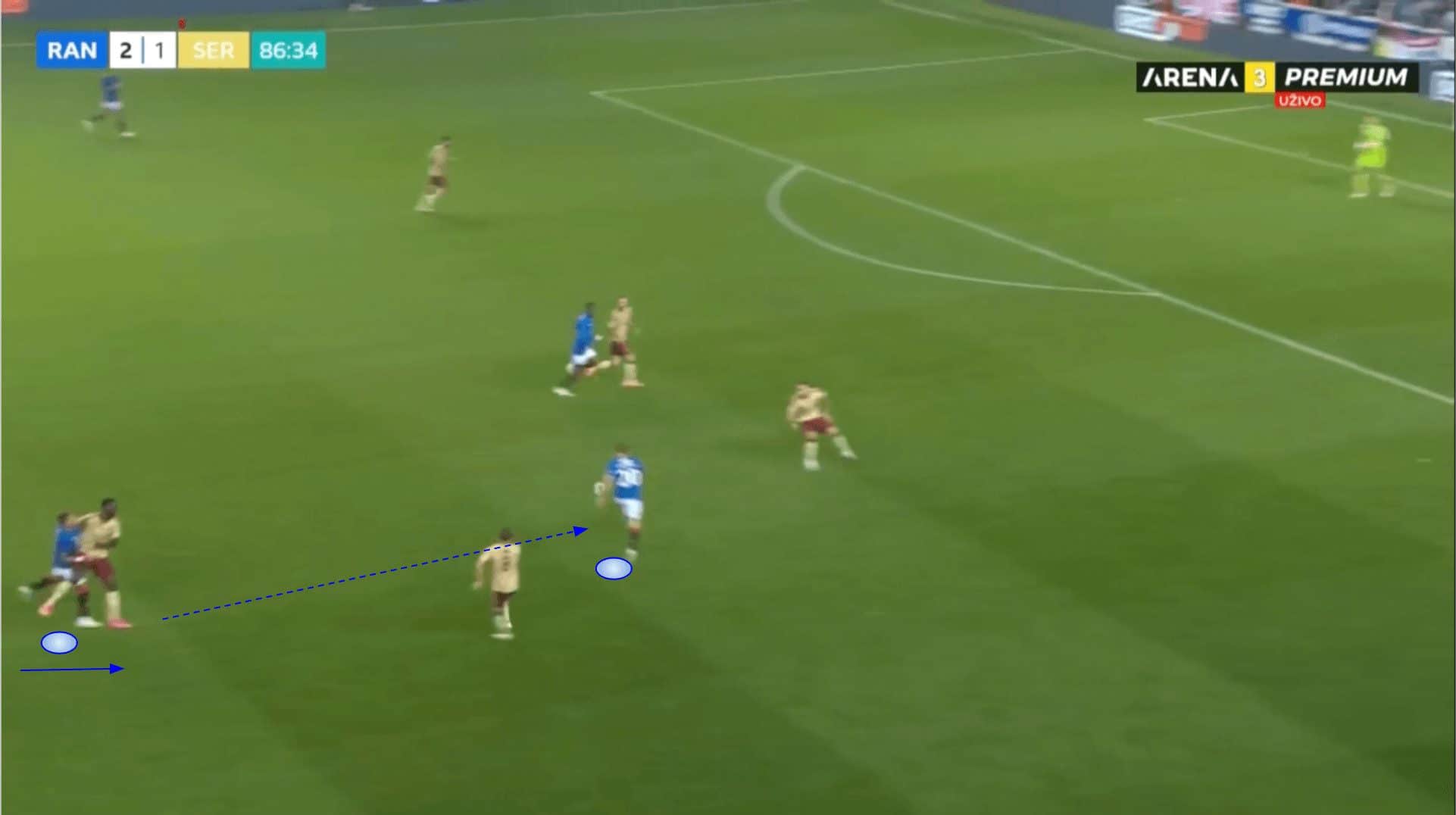
As the Gers reach the opposition’s half, 10 seconds later, Tavernier can find Kieran Dowell in space on the right wing where he can receive and carry the ball inside, continuing this threatening play for the Scottish side.
This is just one example of Rangers’ counterattacking threat from 2023/24 — they’ve provided plenty of them already in the young season for us to confidently earmark this as one of the ways we can expect them to hurt Celtic on Sunday.
Furthermore, this combines with their defensive solidity in that mid-block as previously discussed. They’re good at shutting their opponents down in the ball progression phase before launching a counter. If they can consistently stifle the Hoops’ progression in central areas before countering from those dangerous positions, they’ll create a lot of good opportunities on the break.
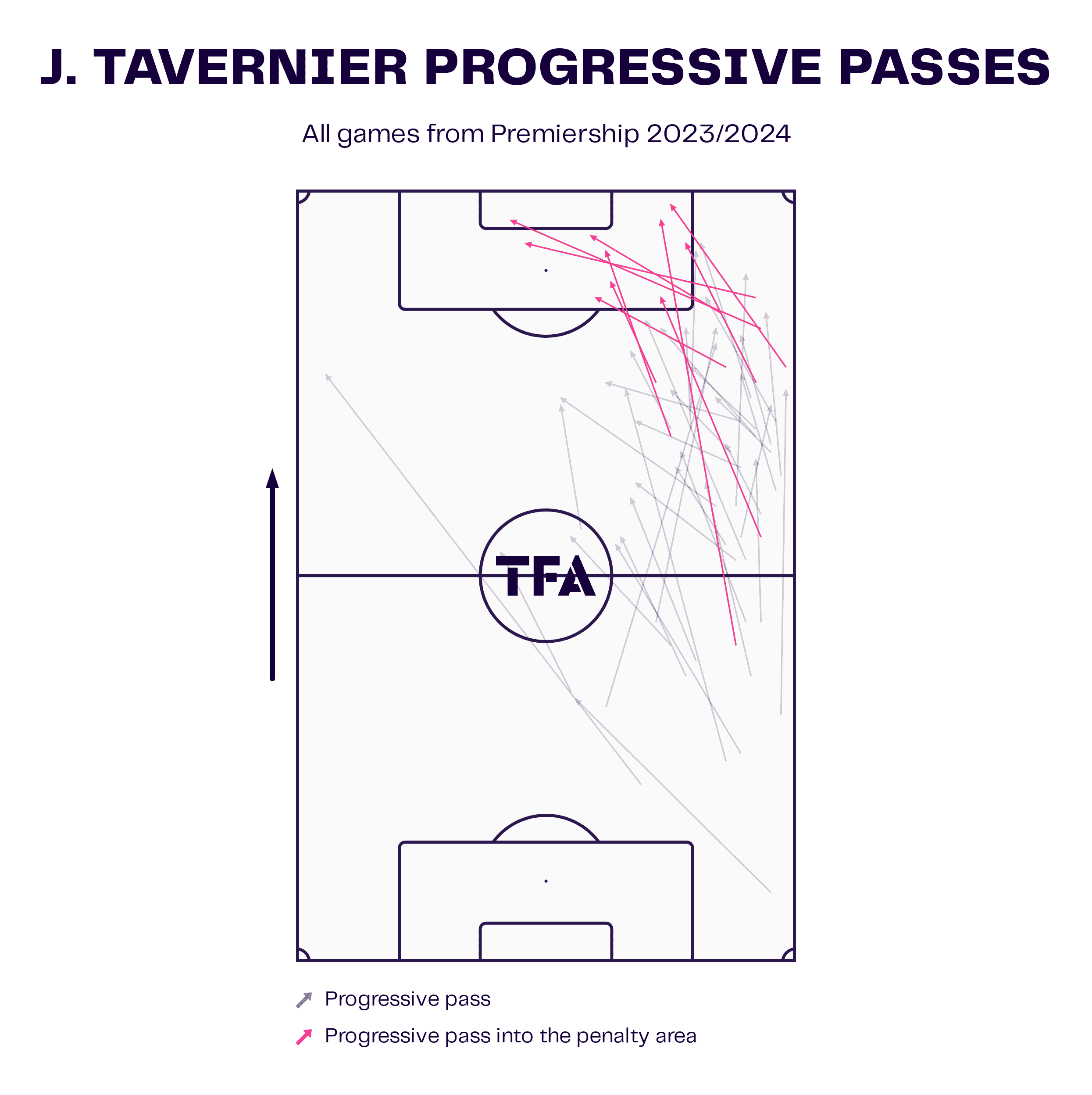
Tavernier will be crucial in the transition to attack as well as the build-up. A lot Rangers’ play moves through the right-back, who has seen more of the ball than any other Gers player this term.
He is a vital aspect of Rangers’ vertical play, both through his ball-carrying — particularly in transition — and through his passing from deep areas on the right hand-side. Celtic will need to have a plan in place to prevent the English right-back from having much time and space on the ball or he will split their defence open with regularity.
Celtic’s strengths
Moving on to Brendan Rodgers’ side and their strengths, with the best xG and joint-most goals scored in Scotland’s top-flight this term, it’s clear Celtic love to be on the ball and pose a major offensive threat in this division, as you’d expect.
Celtic have dominated possession quite a bit this term. They’re not quite as vertical as Rangers and don’t pose as much of a threat in transition. They have a fairly methodical approach designed to consistently create specific types of chances from high-value positions.
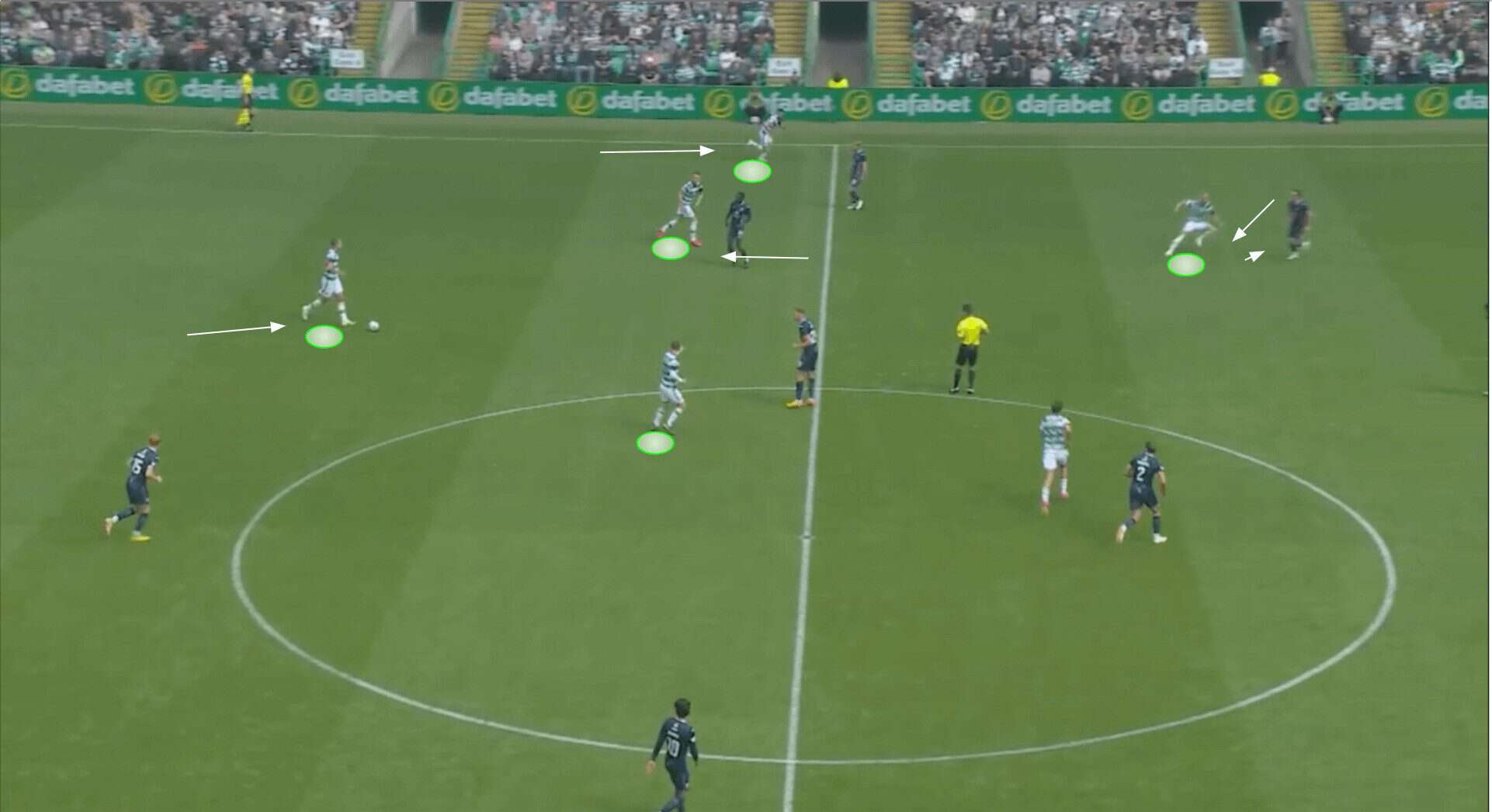
Firstly, Celtic love to get in behind the opponent’s full-backs on the wings. There’s multiple ways in which they can achieve this, with off-the-ball movement designed to manipulate the opposition’s defensive positioning one important part of their possession play.
In figure 6, Celtic’s left central midfielder dropped alongside their deepest midfielder, dragging an opposition player up with him as he was being marked tightly. This created space centrally for Celtic’s left-winger to drop into and threaten to receive, as shown.
At the same time, the Hoops’ left-back began overlapping, threatening to expose the space now vacated on that wing with the opposition’s full-back following the left-winger as he moved centrally.
Not receiving the pass immediately and wanting to avoid remaining static in the centre, Celtic’s winger decided to quickly turn and dart in behind the full-back he’d dragged with him, giving the deep ball-carrier another decent passing option in behind on the left wing.
This is one example of how Celtic manipulate their opponents via off-the-ball movement in the progression and chance creation phases. They can be difficult to deal with as they spot space and invade it in dangerous areas as the left-winger and left-back showcased in this instance. This is something for Rangers to bear in mind for Sunday’s derby.
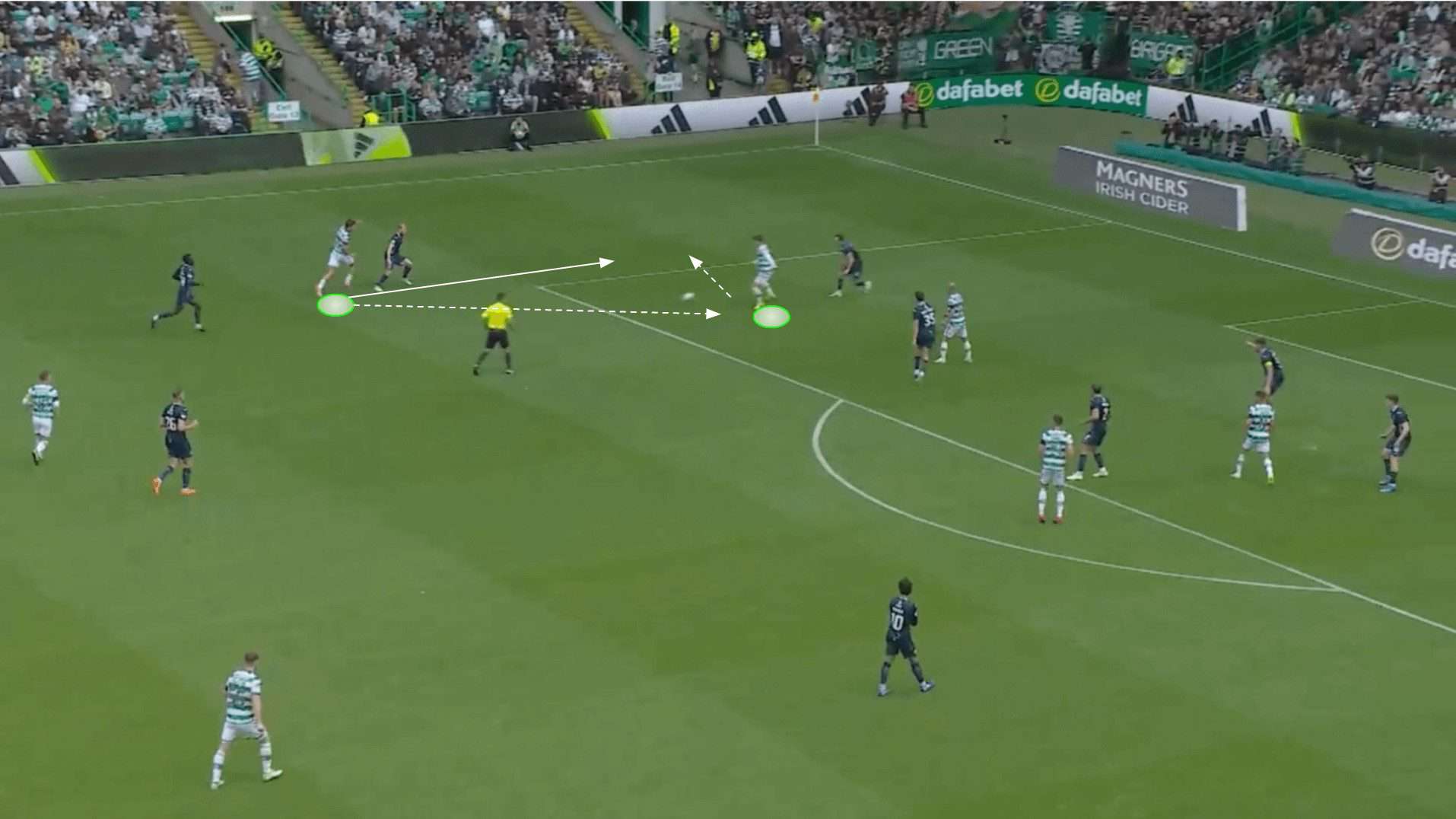
Kyogo Furuhashi has been a vital component of Rodgers’ side’s attack this term as well, including their ventures in wide areas as figures 7 and 8 depict.
The attacker’s link-up play is so important for Celtic’s attacks. Firstly, he creates a passing angle for his teammate with his back to goal. He can receive and, on this occasion, quickly play the ball back, completing a one-two to breeze past the opposition’s right-back.
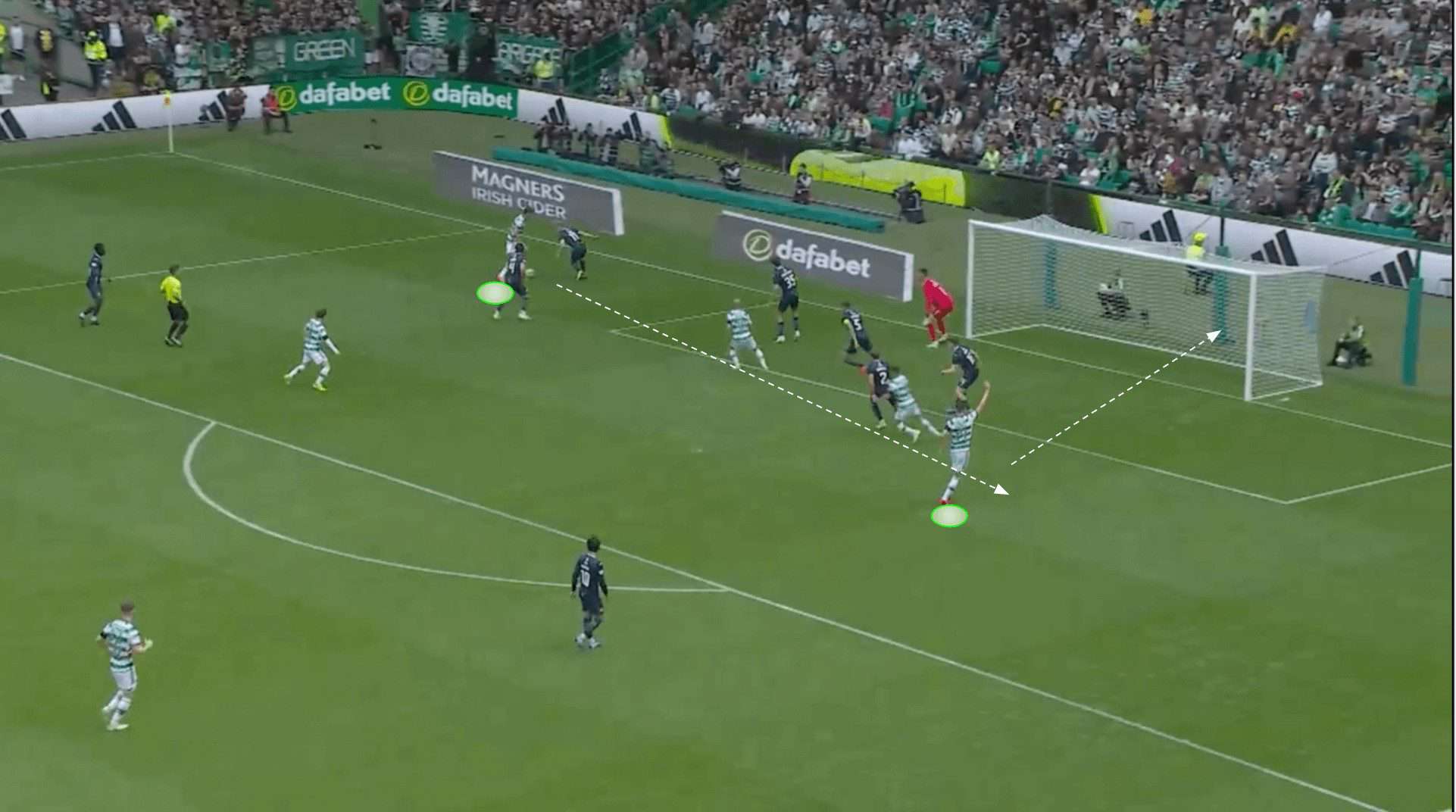
From there, the overlapping left-back can enter the box and create from a decent crossing position. He finds a free man at the back post who’s positioned well to put away the resulting opportunity.
Rodgers’ loves his side to get into these types of positions where they can create good opportunities to cut the ball back or play a short cross and generate a goalscoring opportunity from a highly valuable position.
These chances can be difficult to generate, which may result in Celtic holding onto the ball for a bit longer than they’d realistically like to sometimes as they patiently hack away at the opposition’s defence and work their way into the ideal goalscoring position they’re trying to forge.
Thanks to the attacking quality in their squad, including Kyogo who’s movement, positioning and intelligent passing were crucial in this attack, this is feasible quite a bit of the time.
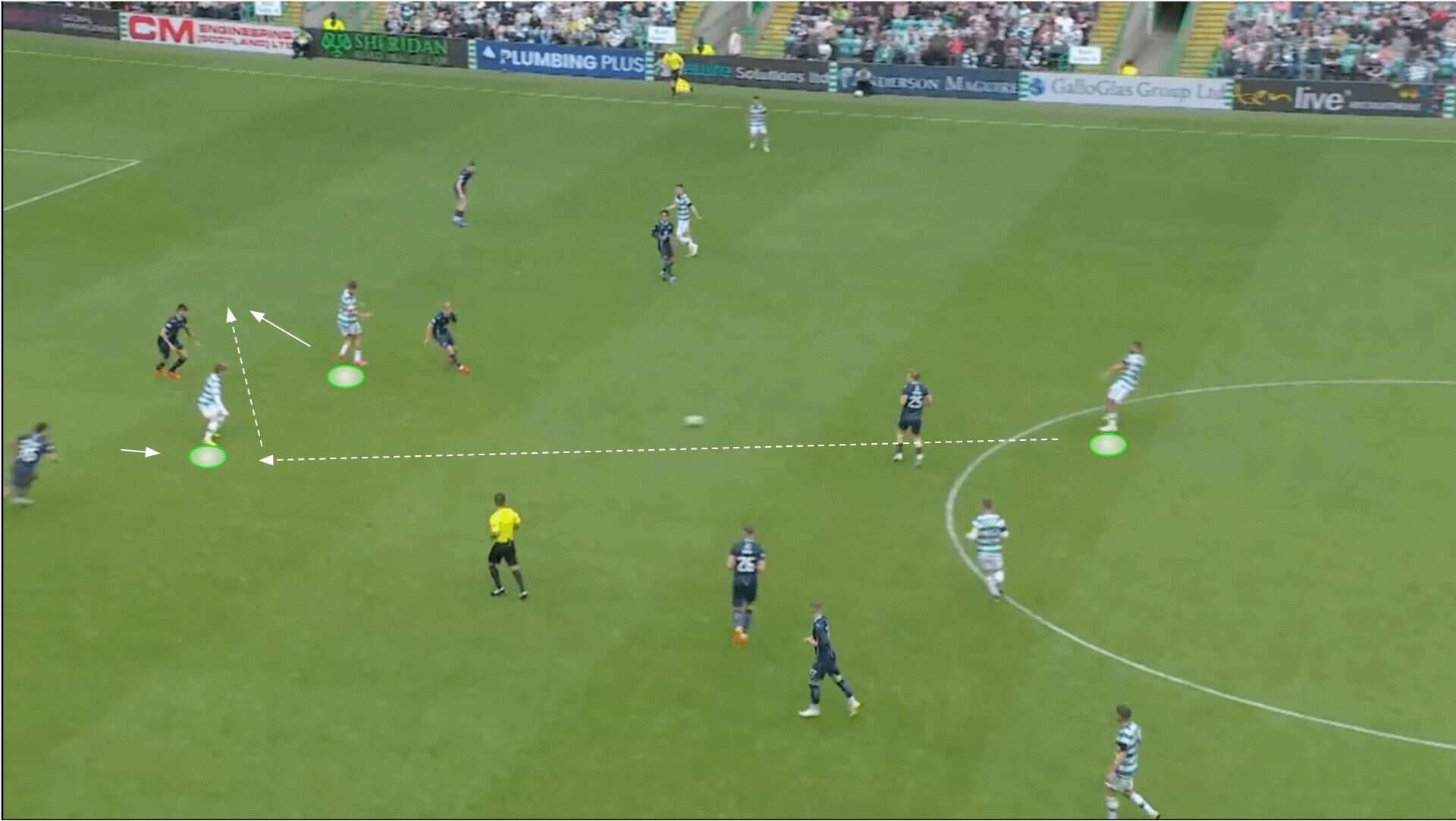
It’s also common to see Kyogo drop off into central areas and receive with his back to goal there, again aiming to provide a link between the middle third and final third via his movement and technical quality.
On this occasion, he created a great passing lane between the opposition’s midfielders and in front of their backline with space to quickly get his next pass off — a through ball for Matt O’Riley, a central midfielder who can advance forward into the striker position as a result of Kyogo’s dropping movement, to chase down and score from.
Kyogo has excellent spatial awareness and frequently performs intelligent movements off-the-ball — these qualities are vital to Celtic’s possession play and the positional rotations they rely upon to break the opposition down, whether that’s centrally or on the wing.
Rangers’ weaknesses
This leads us to areas in which Rangers have displayed weaknesses this term. This is where we can start to draw connections between one team’s strengths and the other’s weaknesses to highlight where we’re likely to see them hurt the other in Sunday’s game.
Firstly, though Rangers’ mid-block and general defensive organisation are undoubtedly major strengths within their game, they’re not faultless off the ball, as PSV displayed in their mid-week 5-1 drubbing of the Glasgow club.
This isn’t to say PSV and Peter Bosz provided a tactical blueprint for how to beat Rangers in mid-week because that’s not entirely true — PSV’s quality with the likes of Johan Bakayoko, Ismael Saibari and Joey Veerman playing starring roles was vital in outshining Rangers in the fashion they did.
However, we can clearly see weaknesses in Rangers’ deep defending, specifically related to their marking and tracking of runners inside the box, that PSV brilliantly exposed in the Champions League playoff.
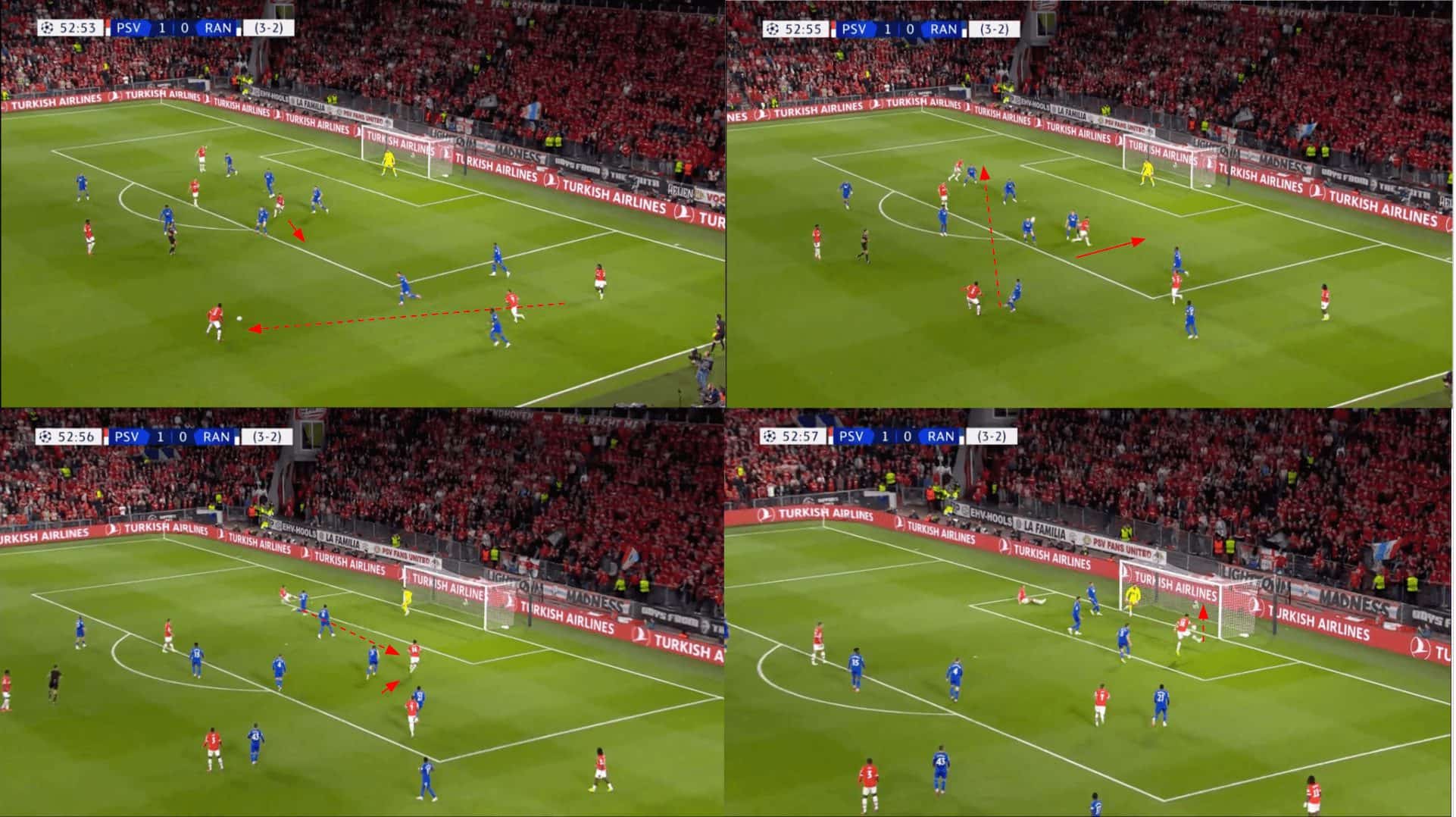
For example, in order to score their second goal of the game, PSV worked the ball into the box via a nice cross directed to the far post.
As Gers centre-back John Souttar’s attention was directed towards that attacker at the back post along with the rest of Rangers’ defence, this bought Saibari the couple of seconds he needed to break free from his marker and end up in lots of space in a very valuable position.
From here, all the receiver at the back post, Luuk de Jong, had to do was drill the ball across the face of goal, setting Saibari up to drill the ball home from close-range with nobody really close to him.
PSV exposed this weakness in Rangers’ deep defending for most of their goals in this game and certainly highlighted this as something Celtic could also expose when they get into the final third.
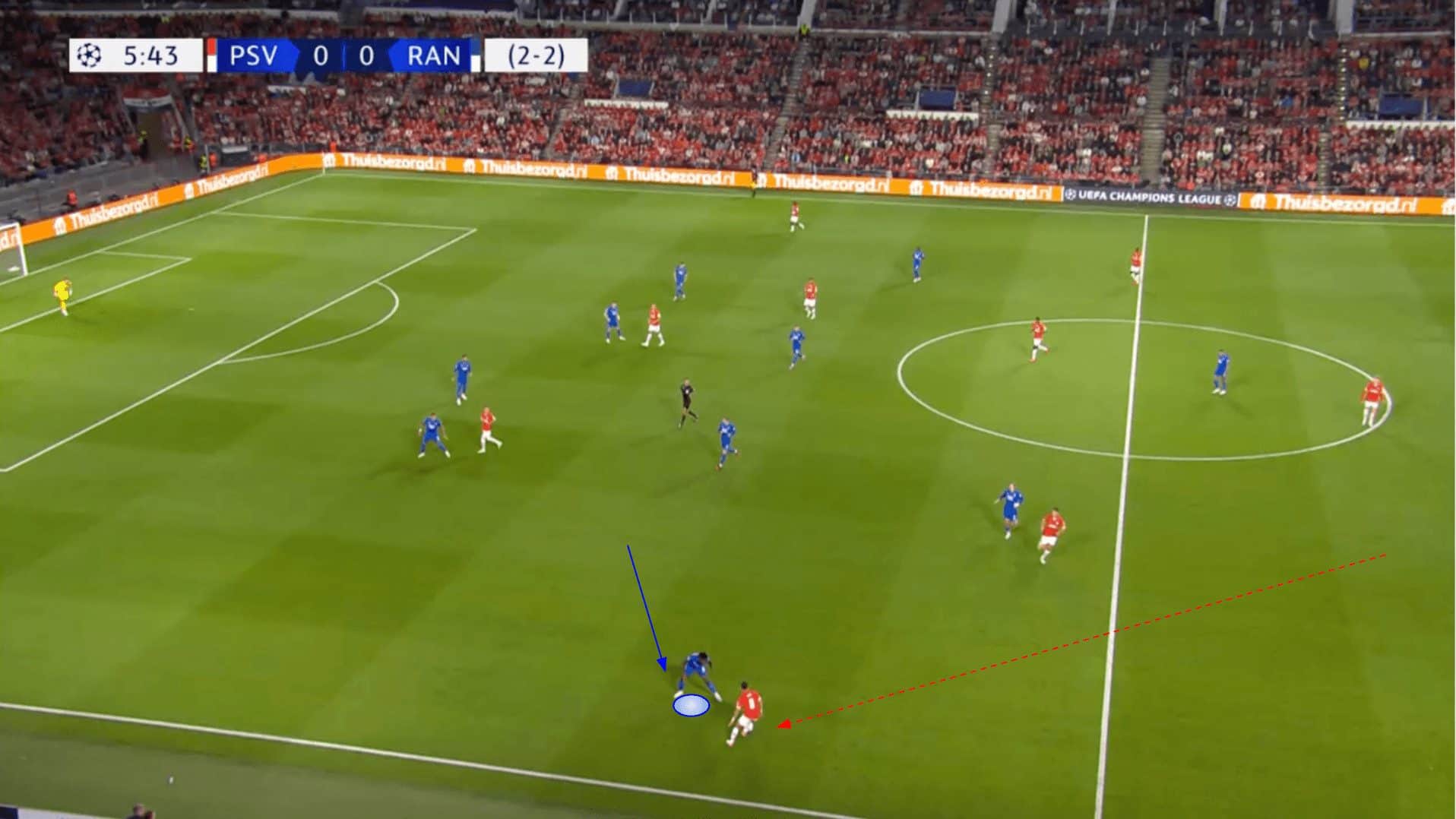
PSV also managed to isolate Rangers’ wide midfielders 1v1 by using the full width of the pitch in the ball progression phase, with wingers/full-backs positioned right on the touchline.
Rangers would send one player out while keeping the rest central, ensuring they prevented this area from being exposed.
This could allow a good dribbler a favourable 1v1 opportunity or create a chance for the team to just play a one-two around a defender like we saw Celtic do versus Ross County in a previous example.
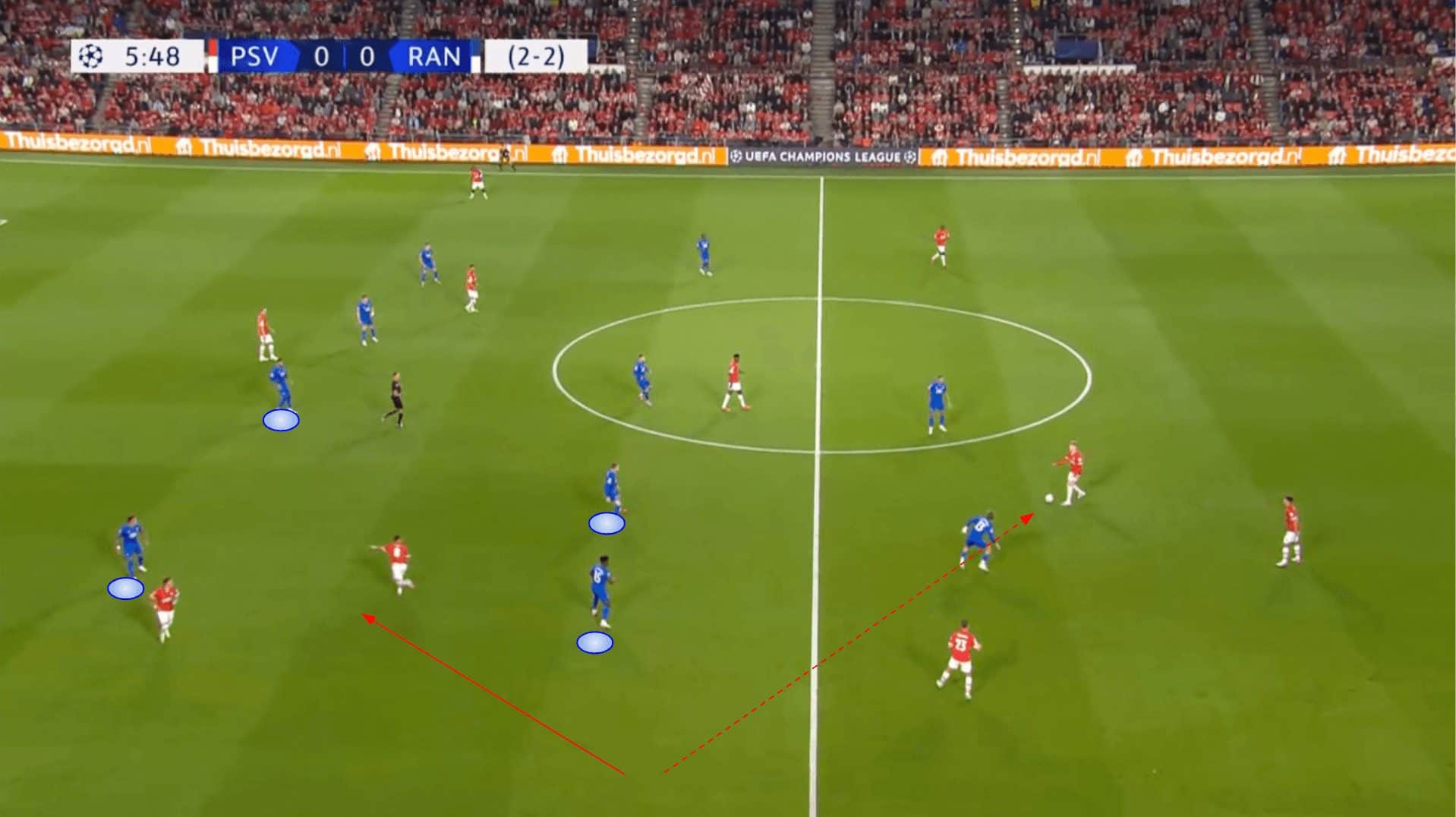
In this case, PSV’s wide man played the ball back before drifting inside as he moved forward, picking up a tonne of space in the left half-space between Rangers’ defence with nobody marking.
The player wasn’t picked out on this occasion, as the passing lane wasn’t viable on this occasion, but this further highlights the possibility for opponents to find and take advantage of space against Rangers.
On this occasion, it was more a result of the position-oriented marking system than anything else that allowed the PSV man to find so much space as he drifted into this area without the ball. Still, we can expect Gers to defend like this versus the Hoops on Sunday and this is something a player like Kyogo, who’s demonstrated ability to hurt the opposition badly via his off-the-ball movement this term, can take advantage of.
Celtic’s weaknesses
Last but not least, let’s move on to Celtic’s weaknesses. Like Rangers, these will primarily be on the defensive side of things but in different ways to their rivals.
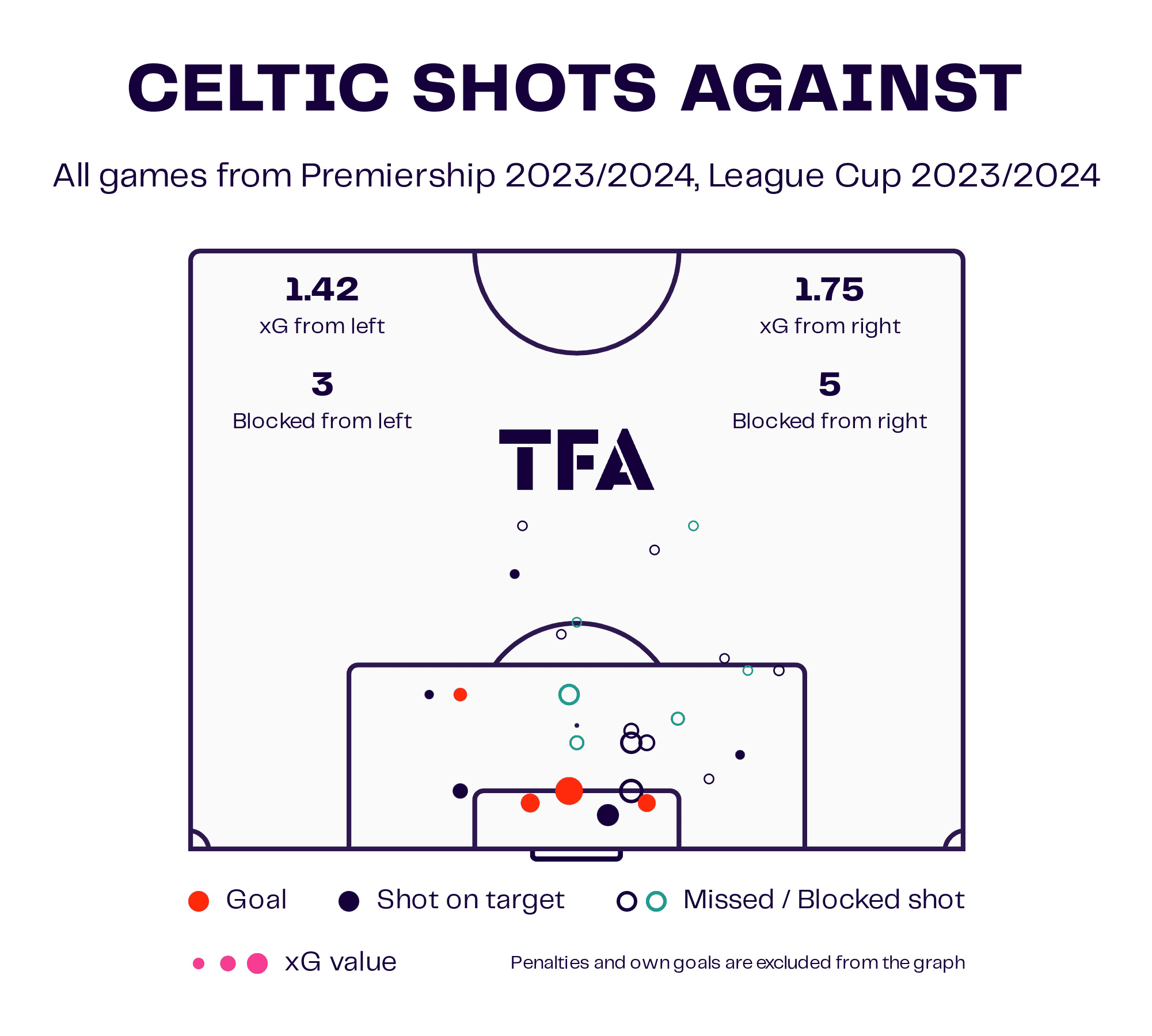
Firstly, we can see a clear difference in Celtic’s shots conceded map compared to Rangers’ from figure 1. Celtic have conceded far more chances from high-quality positions, with slightly more coming from the right than the left.
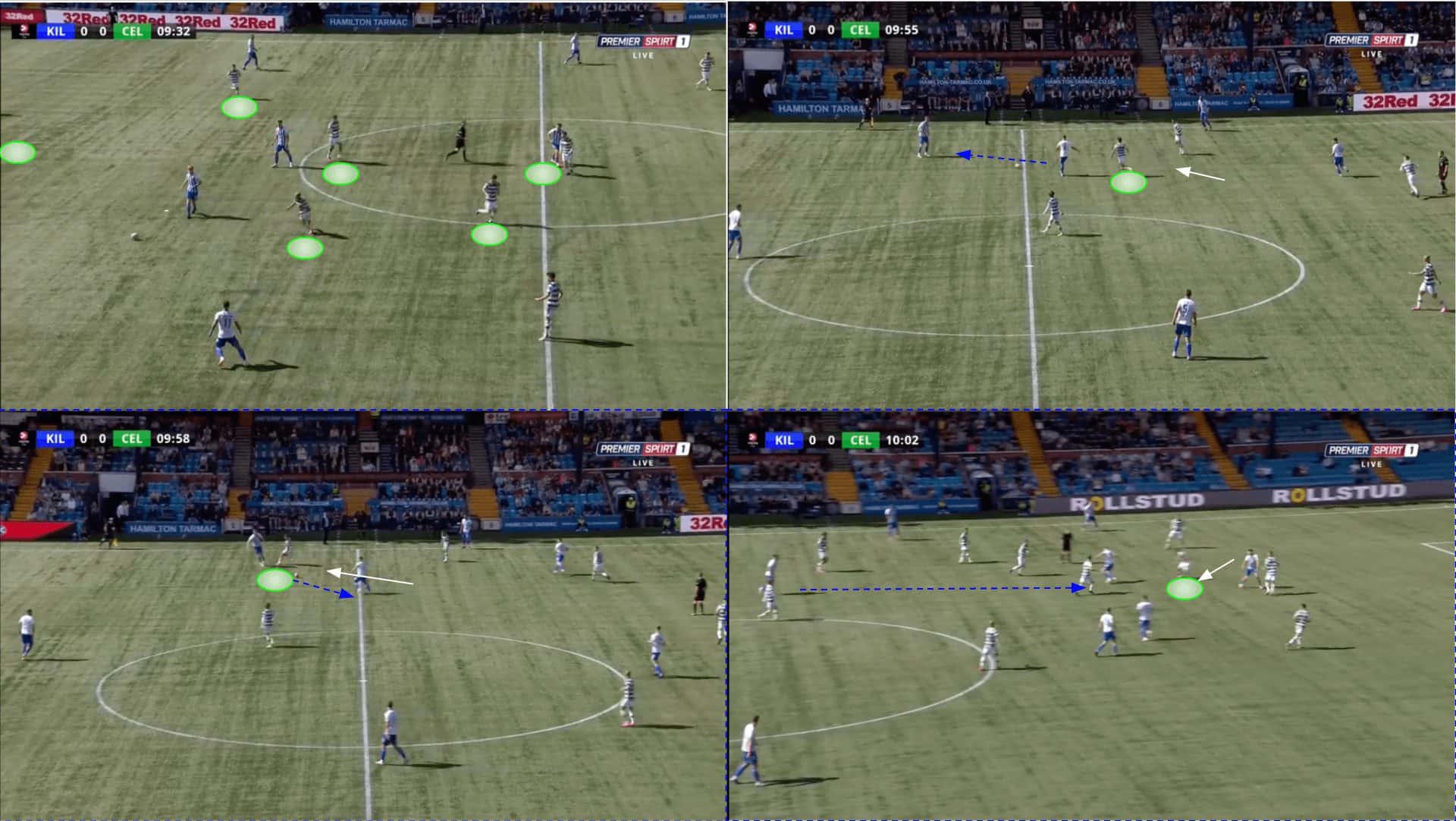
Celtic’s general defensive approach has been far less solid than that of Rangers thus far in 2023/24. The top-left corner of Figure 14 shows Celtic’s 4-2-3-1 setup versus Kilmarnock earlier this season. The Hoops aimed to congest the centre and force the opposition back while pressing aggressively on every pass.
Celtic’s defensive approach is much more option-oriented, rather than position-oriented. The players have to reorganise themselves in relation to the player on the ball and the best passing options available.
This can be successful in denying the opposition much chance at all to string some passes together and can help Celtic make high regains, leading to counterattacking opportunities. However, at the same time, this is quite aggressive and can lead to simple passes being left open if all players fail to commit and press as a unit and close down together, as was the case here, moving from the top-right of figure 14 to the bottom-left.
While the attacking midfielder pressed aggressively, closing down the opposition’s left centre-back as he received, he wasn’t supported by his teammates, leading to a simple passing being played behind the pressing player and into a Kilmarnock midfielder with time and space to turn and progress his team upfield.
This could and should have been avoided with more defensive organisation and full commitment from all players. The lack of this resulted in easy progression for the opposition through the middle of the park.
As they played the ball towards the edge of the final third (the bottom-left image) we’re presented with another aspect of Celtic’s defensive play that could be exposed on Sunday — their centre-backs’ aggressiveness and how it allows space to open up behind them for the opposition to exploit.
Celtic’s centre-backs are generally required to defend high and be comfortable with stepping out to confront attackers. However, there have been plenty of times when this has been exposed this season, whether that’s through some intelligent passing and movement from the opponent or by getting dragged into a 1v1 with a confident and capable dribbler.
Rangers have the quality to slice through the Hoops’ vulnerable press and create these situations on Sunday; expect Celtic’s defence and goalkeeper to be put under immense pressure if they succeed in doing so.
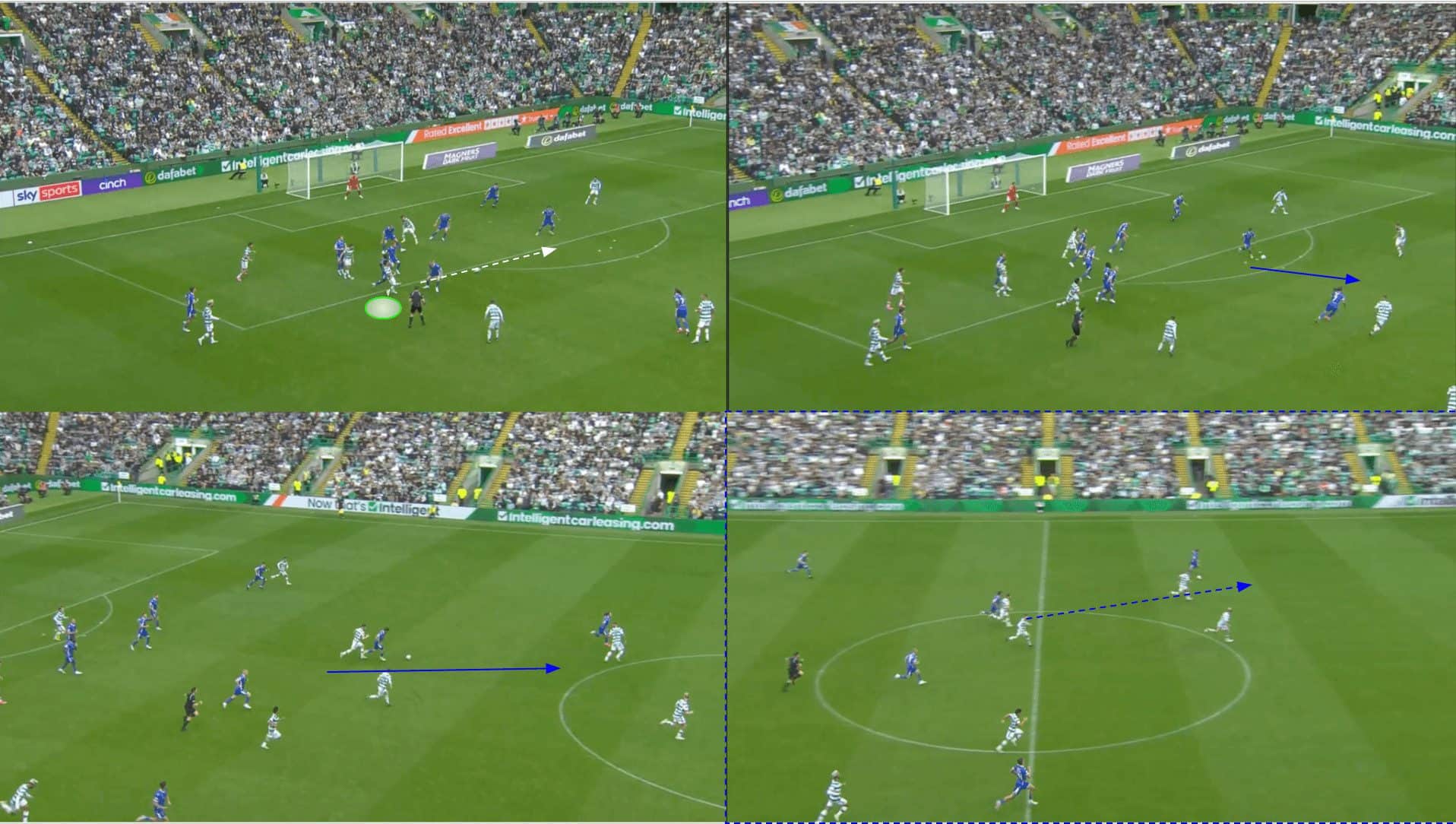
In addition to this, similar issues exist in Celtic’s transition defence, which figure 15 provides an example of. Here, the opposition were able to carve through the Hoops on the counter after Rodgers’ side turned over the ball with a poor pass on the edge of the opponent’s box.
There was a lack of immediate pressure applied to the player who intercepted the ball which allowed him to build up a bit of momentum and get past the Celtic midfielder who did eventually confront him as if he wasn’t there.
He only had to dribble past one Celtic player before reaching the halfway line where he was able to drive a through ball into a teammate’s path, setting him up to attack the opposition’s goal.
Again, a lack of organisation, defensive energy and commitment meant Celtic’s opponents were able to generate a decent opportunity. If they fail to display vastly superior defending on Sunday, Rangers will create valuable opportunities on the counter, where they typically thrive, as we stated earlier — this is somewhere Celtic need to be very careful and bring their absolute a-game this weekend, which they have been far from all season.
Conclusion
To conclude this tactical analysis previewing the first Old Firm derby of the season, both teams have displayed clear strengths and definitely clear weaknesses thus far in 2023/24.
Whoever comes out on top on Sunday will have succeeded in hiding those weaknesses a bit better than they have prior to this game and won the key battles we discussed above.
It’s certainly fair to say neither side are entering the contest with a heap of momentum behind them, so there are very much three points up for grabs at Ibrox.





Comments